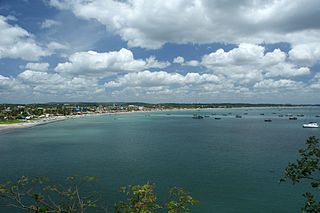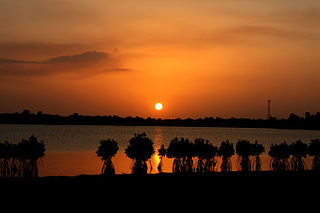
Trincomalee, also known as Gokanna and Gokarna, is the administrative headquarters of the Trincomalee District and major resort port city of Eastern Province, Sri Lanka. Located on the east coast of the island overlooking the Trincomalee Harbour, Trincomalee has been one of the main centres of Sri Lankan Tamil speaking culture on the island for nearly a millennium. With a population of 99,135, the city is built on a peninsula of the same name, which divides its inner and outer harbours. It is home to the famous Koneswaram temple from where it developed and earned its historic Tamil name Thirukonamalai. The town is home to other historical monuments such as the Bhadrakali Amman Temple, Trincomalee, the Trincomalee Hindu Cultural Hall and, opened in 1897, the Trincomalee Hindu College. Trincomalee is also the site of the Trincomalee railway station and an ancient ferry service to Jaffna and the south side of the harbour at Muttur.
Saint Mary's College, is the name of several colleges and schools:

The Eastern Province is one of the nine provinces of Sri Lanka, the first level administrative division of the country. The provinces have existed since the 19th century but did not have any legal status until 1987 when the 13th Amendment to the Constitution of Sri Lanka established provincial councils. Between 1988 and 2006 the province was temporarily merged with the Northern Province to form the North Eastern Province. The capital of the province is Trincomalee. Kalmunai is the largest and most populous city of Eastern Province.

HMS Trincomalee is a Royal Navy Leda-class sailing frigate built shortly after the end of the Napoleonic Wars. She is now restored as a museum ship afloat in the National Museum of the Royal Navy, Hartlepool, England.
The Mavil Aru is a waterway that supplies water to some regions of eastern Sri Lanka. The closing of the sluice gates is considered to be the official beginning of the Eelam War IV although violence including skirmishes and bombings happened before.
Trincomalee massacre can refer to number of incidents of massacres of civilians in the Trincomalee district of Sri Lanka during the duration of the Sri Lankan civil war.

The Eastern Theatre of Eelam War IV started in the Eastern province of Sri Lanka on July 21, 2006 when the LTTE cut off the water supply to rice fields in eastern Trincomalee district. The government claimed total control of the Eastern province after capturing Thoppigala on July 11, 2007, after nearly a year of fighting. Major battles took place at Sampoor, Vakarai, Kanchikudicharu, Kokkadichloai and Thoppigala. Military and civilian deaths were relatively low on both sides. Government forces captured much military hardware from the LTTE during the conflict. The civilians managed to flee the combat zones, and this reduced civilian casualties, while swelling the number of internally displaced people (IDP). The world health organization (WHO) estimated ~200,300 IDPs, and claims that significant progress occurred in resettling them. The LTTE vowed to attack Sri Lanka's military and economic targets across the country to retaliate for the capture of the Eastern province from them. This was stated by the leader of the LTTE's political wing, S.P. Thamilchelvan, in a statement to Associated Press on July 12, 2007.
The Battle of Sampur was fought in 2006 for the town of Sampur.
Sampur is a rural locality in Sampursky District of Tambov Oblast, Russia, located on the Tsna River.
Sampur is a town in the Trincomalee District of Sri Lanka about 30 km south-east of Trincomalee on the south-eastern side of the Trincomalee Harbour. The town was under the control of the Liberation Tigers of Tamil Eelam until 2006, when it was captured by the Sri Lanka Armed Forces.

Ati Konanayakar or Aathi Koneswaram is a regionally important Hindu temple in Tampalakamam village in the Trincomalee District of Sri Lanka. The name of the temple in Tamil means the "temple of the original lord of Koneswaram". It is situated 24 kilometers (15 mi) from the port town of Trincomalee. The temple was constructed during the 17th century as a successor to the Koneswaram temple that was destroyed by Portuguese colonials in 1622.
Trincomalee may refer to:
The Sampur Power Station was a proposed coal-fired power station that was planned to be built in Sampur, Trincomalee, Sri Lanka.

The 1985 Trincomalee massacres refers to a series of mass murder of Tamil civilians by the Sri Lankan military and Sinhalese home guards in Trincomalee District, Sri Lanka. In a succession of events that spanned over two months, hundreds of Tamil civilians were massacred and thousands were driven out by the Sri Lankan military and Sinhalese mobs in order to colonize the area. Almost every Tamil settlement in the district was destroyed during this well-orchestrated campaign to drive out the local Tamil population. Several Tamil women were also raped. In September 1985, the entire Tamil population of Trincomalee town was displaced to forests and refugee camps in an attack that wiped out the town, including the destruction of 12 temples and a mosque. Since August 16, over 50,000 Tamils who were forced to flee the town ended up in refugee camps in the Jaffna and Batticaloa districts.
Kugathas Tharshan was a 6 year old Sri Lankan Tamil boy who was raped and murdered near the Sampur High Security Zone in eastern Sri Lanka in January 2016.
Sampur Soodaikudah archaeological site is a historic site with archaeological evidences, situated in Mathalamalai mountain, Sampur, Sri Lanka. The site was discovered by a group of archaeologists, during an archaeological excavation done in the Sampur area in December 2017. However the ruins, including an old Stupa were completely destroyed and flattened out by a group of vandals on 18 December, few days after the discovery.
This page is based on this
Wikipedia article Text is available under the
CC BY-SA 4.0 license; additional terms may apply.
Images, videos and audio are available under their respective licenses.





